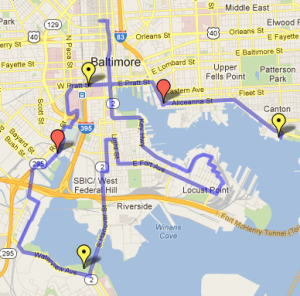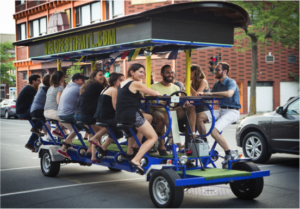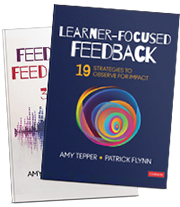A post by Amy Tepper and Patrick Flynn
It’s Like Riding a Bike…Together
This week, we were out organizing our research, yearlong practices, and lessons learned as we prepare to present at the Visible Learning Conference focused on collective teacher efficacy (July 9th & 10th in Chicago). We were immersed in Hattie’s research (Visible Learning for Teachers) and in Donohoo’s “Enabling Conditions” (from her newest work (Collective Efficacy), when we heard it. And then we saw it. A bachelorette party was riding by. Not on motorcycles or individual bikes. But if anyone has had the pleasure of seeing a group of people pedaling away together laughing and cheering, you have seen the latest craze–a party bike.
It was a giant rolling karaoke machine with 14 renditions of Livin’ on a Prayer being sung at one time, when it came to a screeching halt…more laughter….and it inched forward to the next destination. Here it was–collective efficacy right before our tired eyes. We know this may seem far-fetched, but indulge us for a minute…we are a bit loopy from hours of research for our new book having just finished our first book (out next week!).
We were intrigued by the bike riders and found ourselves immediately asking ourselves, “What is making this endeavor so successful for this group?” We were finding our answer in what we know about collective teacher efficacy or the belief that, through collective actions, a group of educators can influence student outcomes and increase achievement, rooted in Bandura’s findings (Donohoo).
Conditions for Success
There are lessons we can learn from our party bikers:
| 1. They had a common goal. (Though theirs may have just been to have fun…they had determined destinations and a shared vision in mind.) Everyone needed to work toward the same goal to move forward and come to a consensus on where they were headed and where they would take a break and stop. Periodically, we saw them pay close attention to how they were doing (like, their speed, effort, if there was equal participation). |
| 2. It relied on the riders to each do their part to go forward. A few of the more athletic ones couldn’t do all of the work. (Some of them tested that theory out.) |
| 3. It brought the riders together in challenge and success. The journey was the reward. They laughed when they were not in sync as much as they did as when they were careening at high speeds. |
| 4. They ultimately had no doubt they could propel this bike through the streets. They boarded tentatively, but as they successfully propelled themselves and gained momentum, they propelled their confidence and belief in their ability to reach their goals together. |
| 5. Most importantly, they had a leader steering the bike and offering feedback. Picture the party bike with no one at the helm! |
Who is at the helm?
Instructional leaders – you are the party bike drivers! You are instrumental in fostering and developing your pedalers’ collective efficacy, and Hattie has identified this as the #1 factor influencing student achievement.
These bikeriders didn’t think too much about their impact on the bystanders, but “teachers, schools, and systems need to be consistently aware, and have dependable evidence of the effects that all are having on their students – and from this evidence make the decisions about how they teach and what they teach.” (Hattie, 2012, p.170)
How and when does this happen?
It will when leaders and teachers:
#1 – believe that their fundamental task is to evaluate the effect of their teaching on students’ learning and achievement
#2 – believe that success and failure in student learning is about what they, as teacher or leaders did or did not do
#3 – want to talk more about the learning than the teaching (Hattie’s Mindframes, 2017)
This will occur when teachers:
- clearly understand expectations and
- develop an accurate perception of their own standing against those expectations.

Because leaders:
Shift from practices of inspection to observation and feedback for learning–and to support teachers in doing the same for their peers–to include:
- evidence-based observation focused on collecting information on student engagement and learning
- analysis of “causal attributions” (Bandura) to help teachers see their impact
- development of high quality feedback that is actionable and offers teachers the opportunity to grow.
Observation and feedback are at the heart of collective efficacy. How are you as leaders driving toward common goals and a shared understanding of expectations for teaching and learning with your riders?
We aren’t saying schools should be like party bikes…or are we?
After all, Bon Jovi says, “We’ve got each other and that’s a lot…”
See you in Chicago!





Leave a Reply